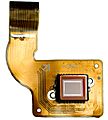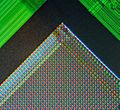Image sensor
An image sensor is a special electronic device that can capture and record an image. Think of it as the "eye" of a digital camera or phone. These sensors usually work by finding out how much light there is and how strong it is.
Most image sensors are made to see visible light, which is the light we can see, and infrared light, which is heat light. But there are also special sensors that can detect things like X-rays and gamma radiation.
In 2020, the two most common types of image sensors were called CCD and CMOS. These are just different ways to build the tiny parts that capture light.
Contents
How Image Sensors Work
Image sensors are made of millions of tiny parts called "photosites." Each photosite is like a tiny bucket that collects light. When light hits a photosite, it creates a small electrical signal. The brighter the light, the stronger the signal.
Turning Light into Pictures
After the photosites collect light and create electrical signals, the sensor quickly reads all these signals. It then turns them into digital information. This digital information is what makes up the picture you see on your screen.
Types of Image Sensors
There are two main types of image sensors you'll hear about: CCD and CMOS. Both do the same job of capturing light, but they do it in slightly different ways.
CCD Sensors
CCD stands for Charge-Coupled Device. In a CCD sensor, each photosite collects light and creates an electrical charge. These charges are then moved, step by step, across the sensor to a single "output" point. At this point, the charges are measured and turned into a digital signal.
CCD sensors are known for making very clear and high-quality images. They were very popular in older digital cameras and are still used in some scientific cameras.
CMOS Sensors
CMOS stands for Complementary Metal-Oxide-Semiconductor. In a CMOS sensor, each photosite has its own tiny electronic circuit right next to it. This circuit reads the electrical signal from that photosite directly.
CMOS sensors are often found in modern smartphones, webcams, and many digital cameras. They use less power than CCD sensors and can be made smaller and cheaper. They also tend to be faster at capturing images.
Where Image Sensors Are Used
Image sensors are everywhere in our daily lives!
In Cameras and Phones
The most obvious place you'll find image sensors is in digital cameras and smartphones. They are what allow you to take photos and videos of your friends, family, and everything around you.
Other Cool Uses
Image sensors are also used in many other cool technologies:
- Webcams: For video calls with friends or online classes.
- Scanners: To turn paper documents into digital files.
- Medical imaging: Like X-ray machines that help doctors see inside your body.
- Security cameras: To keep places safe.
- Self-driving cars: To help cars "see" the road and other vehicles.
- Space telescopes: To capture amazing pictures of distant stars and galaxies, even in infrared light like the Orion Nebula.
- LiDAR sensors: These are special sensors that use light to measure distances, often found in new devices like some iPads to create 3D maps of rooms.
Image sensors are a key part of how we capture and share moments in our digital world!
Images for kids
-
An American Microsystems, Inc., (AMI) 1-kilobit DRAM chip (center chip with glass window) used as an image sensor by the Cromemco Cyclops
-
A micrograph of the corner of the photosensor array of a webcam digital camera
-
Infrared view of the Orion Nebula taken by ESO's HAWK-I, a cryogenic wide-field imager
See also
 In Spanish: Sensor de imagen para niños
In Spanish: Sensor de imagen para niños







